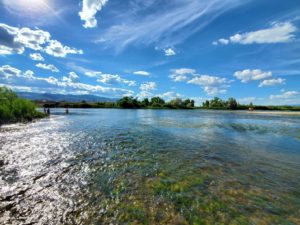
“If the nutrient load is the gun, heat is the trigger,” said Derf Johnson, the Clean Water Program Director and staff attorney at the Montana Environmental Information Center in Helena, Montana. These are pretty serious words for a man talking about algal blooms in Montana.
It was Day 15, our off day in Helena. Group morale was high but the heat from the day was becoming overwhelming. Any hope of escaping it indomitability fell away with the sweat dripping from us, a group of heat-exhausted WRFI students sitting in a conference room at the MEIC to meet with Connor Ploegar and Derf Johnson. I had been looking forward to this meeting for some time.
Derf was calm, cool and collected despite the heat. We began talking about water. His composure expired. The room seemed to get even hotter. Combustion seemed inevitable.
As many of us reawakened from what might reasonably be called a heat coma, we were excited to see what an impassioned and opinionated Derf Johnson had to say about this new bill and the latest legislative session that ended in some very disappointing rollbacks. Connor mentioned SB 358.
Boom.
The latest legislative session, explained Derf, was disappointing for a number of reasons, but chief among them was the lack of conversation about climate change and energy issues, both of which he contends are of the utmost urgency. Derf set off on a verbal expedition explaining the pitfalls of the legislative session’s misguided direction. We heard “SB 358” once again. Derf explained.
This bill changed the regulations that point-source polluters are required to adhere to as they discharge nutrients (phosphorus and nitrogen) into Montana’s lakes and rivers, from numeric to narrative. Why is this a problem Derf asks us? Because where numeric standards held polluters to very strict standards based on measurable levels of nutrients, the new standards stipulate that the polluted water remains fishable, drinkable and swimmable. In other words, the standards themselves have become subjective.
Just the week before, a group of worn and weary WRFI students stepped into the Missouri River only a few hundred yards above Canyon Ferry Reservoir. I couldn’t suppress the fear and rage that was growing inside me as we waded deeper and deeper into the river; this water is too warm and the flora growing on the river bed is far too thick for early July. In this moment, I found myself scared.
Derf continued. Instead of drafting legislation aimed at reworking Montana’s grid to become more compatible with renewable sources of energy, or working to incentivize utility companies to pursuit more sustainable options, the latest session was overwhelmingly focused on pushing through legislation that had nothing to do with environmental regulations. We heard about the new water quality bill again.
Derf launched into another impassioned speech. As nutrient discharge increases, so will the frequency and intensity of the already problematic algal blooms. Blooms caused by a combination of heat, which we are seeing more of, and excess nutrients, which Derf feels there will now be more of in the water. These blooms deprive the local ecosystems in which they occur of oxygen and thus the health of local plant and wildlife. Like Derf said, “If the nutrient load is the gun” and “heat is the trigger,” we can expect some serious gunshots to start going off around the state.
In 2020 the DEQ reported that 35% of Montana’s river miles, and 22% of its lake acres, host nutrient levels that exceed existing limits. And yet the Montana legislature loosened those restrictions, even as climate change is making the problem worse. Derf demands better. SB 358 allows for worse.
The lonely DeVita filter makes one last lap around the impossibly stuffy room. Derf composed himself. He takes a deep breath and offers us a cheeky smile. The conversation turned hopeful as we learn that the Upper Missouri Water Keepers have petitioned the EPA to review the bill’s provisions as they are in violation of the Clean Water Act, which prohibits any rollback in regulations pertaining to the establishment and enforcement of water quality standards. The importance of the work the MEIC carries out came into better focus. At the very least, if state governments refuse to help guide us towards a sustainable future, there are organizations like the MEIC to help out.
I leave concerned but ready to take up the fight.
Dominic Corradino is a student at Montana State University, where he is majoring in Liberal Studies and Environmental Studies. He is originally from Boulder, Colorado.